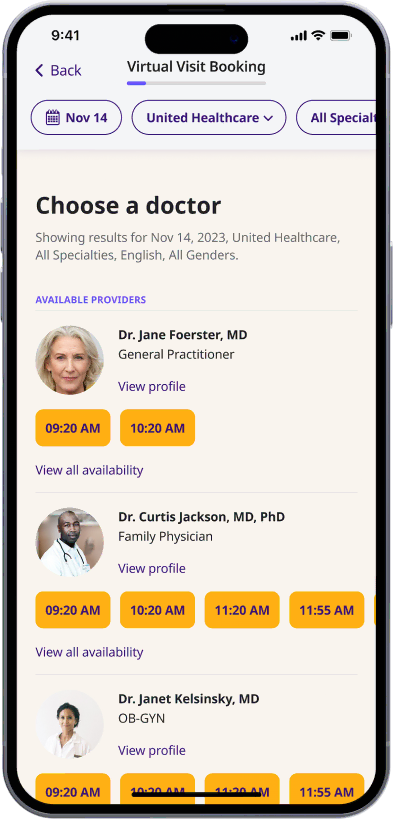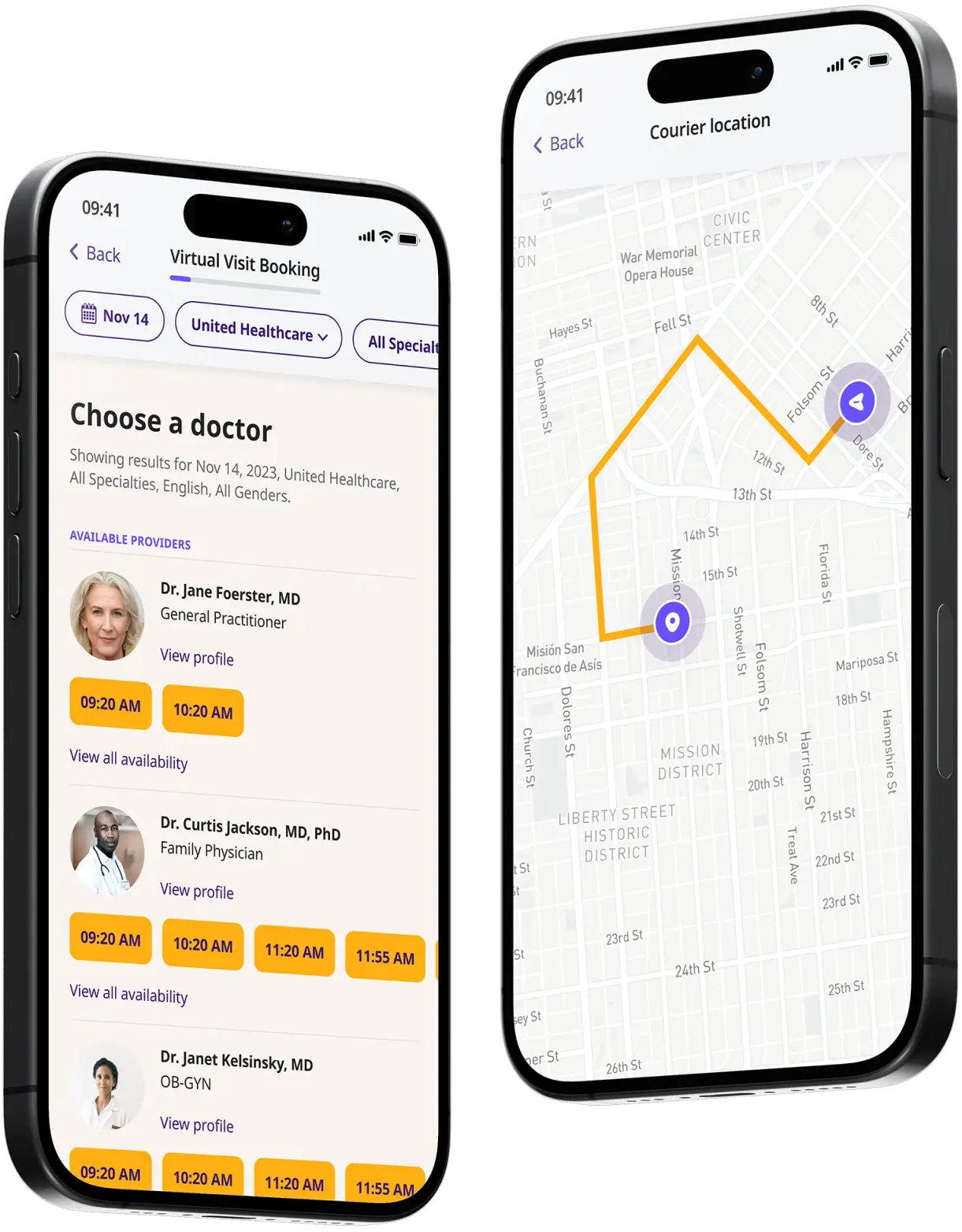Virtual Primary Care Available 24/7
Get reliable, 24/7 primary care online with DrHouse—personalized healthcare whenever you need it.
WE CAN HELP YOU WITH
Available in 50 states. Insurance accepted.
Fast
virtual visits
24/7 care
assistants
Prescriptions
as needed



See If Delivery Is Available Near You
Delivery Not Available
Enter your ZIP code to check if prescription delivery is available in your area and how soon your meds could arrive.
How to get started
Choose your doctor, start a virtual visit, and have your prescriptions sent to your preferred pharmacy for pickup — all in just a few easy steps.
Choose a doctor
Choose a physician by availability, specialty, ratings, and more.

Start a video call
Get connected with a doctor anytime, anywhere.

1-Hour Rx Delivery
Your prescription delivered to your door in 1 hour or less.

Available in 50 states. Insurance accepted.
One-Time
Physician Visit
One-time visit with a physician for diagnosis, treatment, Rx, labs, referrals, and doctor’s notes.
Accepted Insurances
See why people turn to DrHouse...
Healthcare on time!
Consult with a board-certified healthcare professional in 15 minutes or less.
Download our app

About Virtual Primary Care
Primary care is a day-to-day well-being and healthcare service that focuses on diagnosing and treating a broad range of illnesses, preventing diseases and managing chronic conditions.
Virtual primary care is the digital equivalent of in-person primary care, the only difference being that it’s done online through a digital channel. A virtual visit with a primary care provider is just like an ordinary doctor’s appointment that you can make from the comfort of your home by using the DrHouse app on your mobile device.
DrHouse is the fastest, easiest and most affordable way to see a doctor, with us there is no need to worry about unexpected bills at the end of the visit. You are always consulting with world-class medical professionals who will listen to your concerns and make further decisions.
How can DrHouse virtual primary care help you?
Most times you need medical advice right away and don’t have time to wait days, weeks, or even months to get treatment. There is no need to wait anymore because DrHouse virtual primary care clinicians are always there for you 24/7. You can start a virtual visit any time of the day and speak to a doctor within 15 minutes!
Our primary care providers are experienced and deal with a variety of health problems on a daily basis. We can help you with medical conditions such as allergies, arthritic pain, asthma, bronchitis, colds and flu, diarrhea, infections, insect bites, pharyngitis, conjunctivitis, rashes, respiratory infections, sinusitis, skin inflammations, cellulitis, sore throats, sprains & strains, bladder infections, UTIs, sports injuries, vomiting and more.
Who is virtual primary care for?
Virtual primary care is for everyone who would like to get medical advice, medical care, fast prescriptions, and prescription refills online without having to leave their home. Our clinicians will diagnose, create a treatment plan, and advise you on different medical conditions.
How is virtual urgent care different from virtual primary care?
While telehealth has helped many people get fast and reliable care during the pandemic, allowing them to consult with a medical professional remotely, most virtual urgent care visits lack continuity and are often not pursued with a follow-up visit.
With DrHouse it is possible to schedule a follow-up appointment with your online doctor by requesting a scheduled appointment from DrHouse care support. We will then arrange a meeting with your DrHouse primary care provider. This helps to create essential relationships between a patient and provider just like in traditional primary care.
Virtual Primary Care For Chronic Conditions
Chronic conditions such as diabetes, hypertension, and asthma require frequent follow-ups and adjustments to one’s medical treatment. With DrHouse you can manage your health condition with an online doctor available on demand. Our clinicians are experienced in managing chronic conditions and can help you monitor your condition, adjust medications, prescribe new medication and answer any questions you might have.
Some chronic conditions we can help with:
Diabetes
Diabetes is a chronic medical condition in which the body either does not produce enough insulin to regulate blood sugar levels, or does not properly use the insulin it does produce. Insulin is a hormone released by the pancreas that helps turn glucose (sugar) in food into energy that can be used by the body. When diabetes is uncontrolled, it can cause serious health complications and even lead to death. With regular monitoring and medical treatment, diabetes can be managed successfully.
Diabetes requires regular monitoring and oversight, which is why DrHouse offers an online doctor that can provide you with all the necessary care. With our virtual primary care services, we can provide personalized treatment plans and provide online prescriptions as needed in order to help you manage your diabetes.
Hypertension
Hypertension, commonly known as high blood pressure, is a medical condition in which the force of the blood pushing against the walls of the arteries is too high. It can have serious health consequences and needs to be monitored and managed carefully.
DrHouse virtual primary care enables you to receive hypertension medication and advice from an online doctor. Our clinicians have experience in managing hypertension and can answer any questions you might have, adjust medications as needed, provide online prescriptions, and give valuable insight into lifestyle changes that could benefit your condition.
Arthritis
Arthritis is a common condition that causes inflammation, joint pain, and stiffness. It can affect people of all ages, genders, and backgrounds. While there is no cure for arthritis, regular treatment can help manage the symptoms and improve quality of life.
At DrHouse we offer online consultations with experienced clinicians who can provide personalized treatment plans, and online prescriptions and answer any questions you might have.
High cholesterol
High cholesterol is a condition in which there is an excessive amount of cholesterol, a type of fat, in the blood. It can be caused by unhealthy lifestyle habits such as smoking and poor diet. High cholesterol increases one’s risk for cardiovascular disease, stroke and heart attack.
By consulting with our doctors online we can provide tailored treatment plans and medication to help you manage your cholesterol levels. We can also offer lifestyle advice that could help reduce the risk of further health complications.
Asthma
Asthma is a chronic inflammatory lung disease that causes recurrent episodes of wheezing, breathlessness, chest tightness, and coughing. It affects people of all ages and can range from mild to severe. During an asthma attack, the airways of the lungs become inflamed and constricted, making it hard for air to pass through. It can be triggered by exercise, allergies or exposure to certain irritants.
At DrHouse we understand how important it is to manage asthma and reduce the risk of an attack. We offer online consultations with our experienced clinicians, who can provide personalized treatment plans and online prescriptions to help you manage your condition. Our virtual primary care doctors can also provide helpful lifestyle advice to help reduce the risk of further health complications.
Hearth disease
Heart disease, also known as cardiovascular disease, is an umbrella term for a number of conditions that affect the heart and blood vessels. It includes coronary artery disease, arrhythmias, and congenital heart defects. Heart disease can be caused by genetic factors such as family history or lifestyle choices such as smoking or poor diet.
At DrHouse we can provide online consultations with our experienced clinicians to help you manage your heart disease. We can provide personalized treatment plans, medication and lifestyle advice that could help reduce the risk of further complications. Our virtual primary care services are designed to make sure you get the care and attention you need to stay healthy.
Migraine
Migraine is a neurological disorder characterized by recurrent episodes of intense headache, nausea, and vomiting. It can also be accompanied by sensitivity to light and sound, as well as fatigue and blurred vision. Migraines typically last from 4 to 72 hours, but may last longer in some cases. The exact cause of migraines is still unknown
At DrHouse we understand how debilitating migraine can be and offer online consultations with our experienced virtual primary care clinicians who can provide personalized treatment plans and online prescriptions to help you manage your symptoms.
Frequently asked questions

Related services
Explore more of our services tailored to your needs and discover additional ways we can support your healthcare needs.

